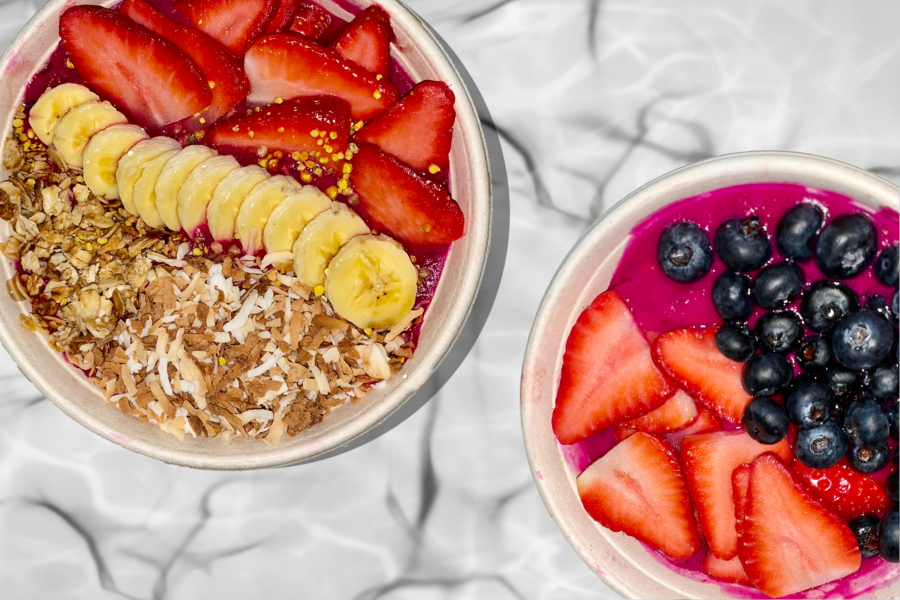Students invest in healthy eating as living a healthy lifestyle grows in popularity
Acai bowls are one of many food items that have grown in popularity since the surge in the organic food market in the United States. Photo illustration by Madison Lenard
March 4, 2021
Six years ago, only 30% of Americans bought organic food; however, a national study has discovered that 83% of Americans do so today. Over the years, individuals have developed a desire to become more educated and aware of the products they are purchasing as labels like “all-organic” begin to attract the eyes of consumers.
According to several studies, such as a Global Health & Wellness Survey by Nielsen, a global measurement and data analytics company, throughout the United States, the concept of maintaining a healthy, all-natural diet has grown in popularity in recent years. Due to this, there has been a surge in the health food industry, with the introduction of numerous restaurants primarily focused on serving fresh and nourishing food.
Public attitudes have evolved rapidly as influencers on social media platforms encourage their audiences to eat more organic foods. On social media, celebrities oftentimes endorse items, persuading their followers to buy those products. Well-known American actress, Daniella Monet, provides her Instagram followers with tips and recipes for homemade, healthy meals and incorporates endorsed plant-based products throughout her feed. As a vegan, she encourages others to expand their knowledge in relation to the food industry and in what they are truly consuming.
Some individuals are persuaded to eat more healthy foods because they believe it is vital in feeling better, both mentally and physically. As they continue to eat these nutritious options, individuals find themselves being more motivated and active.
“Maintaining a healthy diet has many proven benefits, such as a longer life span, greater energy and overall well-being,” senior Alexander Miller said. “It contributes to the activities I participate in, such as cross country and track.”
As the demand for organic food increases, the industry continuously re-markets its products to ensure their goods maintain the appealing image that attracts their buyers. Brands’ marketing teams ensure that they correspond with the new trend, pleasing consumers with several labels, such as “no-artificial flavor added,” “non-GMO,” “multi-grain” and “organic” on the packaging of their products.
“I often look for certain labels such as ‘all organic’ in order to ensure that the food I buy is healthy,” senior Lindsey Salomone said.
In order to maintain a more organic diet, people are eating more home-cooked meals. According to a study by the FDA, those who decided to continue along the route of eating at home experienced a calorie intake decrease of about 127 calories per day. Food cooked at home is likely to be more nutritious, and consumers are more likely to check the ingredients before purchasing and eating a home-cooked meal.
“Eating at home makes sure you know every ingredient in your food and this helps achieve the goals I set for myself,” senior Michelle Lapidot said.
According to a survey published by the International Food Information Council and the American Heart Association, 95% of Americans search for the “healthy option” when shopping. This implies the majority of Americans who are committed to living a more healthy lifestyle.
Individuals have begun to invest in this new lifestyle, eager to improve their well-being through the consumption of more balanced meals and less artificial ingredients. When people go out, many favor the restaurants known for their healthy food options and the popular earthy aesthetic that is often paired with them.
“I love going to places like Juicery Rx because everything is super organic and still tastes so good,” sophomore Elayna Auster said. “When going out I tend to look for the healthier options, and these kinds of restaurants always have the best food in that sense.”
Some of these healthy restaurants sell various types of vegan and gluten-free food items, including wraps, salads, smoothies and açaí bowls. As individuals continue to prioritize their health, restaurants have monetarily benefited by charging higher than average prices because of their pure ingredients.
In addition to supporting healthy food restaurants, there are numerous food trends that people are participating in. Some of the most popular ones include plant-based proteins, açaí bowls and fruit flour. These trends have become very common in recent months in an attempt to establish a healthier diet.
Plant-based proteins are said to have far more of an environmental impact while enabling an individual to lose weight and eat less red meat. Plant proteins tend to be lower in calories and fat, as well as higher in fiber and essential nutrients. Some of the most common sources of protein are hemp seeds, quinoa and lentils.
“I’ve been a vegetarian for about four years now and throughout that time period I’ve relied on foods like beans and quinoa for my protein substitutes,” senior Hannah Kravec said. “There are so many delicious meals I can make with them while simultaneously being provided with the nutrients I need.”
Like any food product, the quality often depends on the brand. One of the most popular brands, Beyond Meat, is said to taste like a beef-based hamburger; however, the amount of saturated fat is quite similar to a classic burger.
Açaí bowls are becoming a popular treat, not only in the United States as a whole, but also locally. Most açaí bowls are high in fiber, antioxidants, vitamins and minerals. The delicacy is considered a super food, made of all-natural ingredients, promoting a healthy lifestyle.
Another newly popular item on the market is fruit flour, a replacement for flour that provides individuals with gluten-free alternatives. In doing so, individuals are able to bake healthier and more enjoyable foods. For example, apple flour and banana flour have become quite popular in both the gluten-free community, as well as for those who are simply yearning for another healthy alternative. These fruit flours provide people with fiber, potassium, antioxidants and a sweet flavor, all depending on the type of fruit used.
These trends are meant to attract consumers by providing them with more options that correlate with the health food craze. In doing so, stores and restaurants are making themselves more appealing in the eyes of the consumer.
According to a survey published by the International Food Information Council and the American Heart Association, the 25 to 34-year-old age group appeared to be the most health-conscious. This is due to their involvement in social media, their peers and their exposure to recent trends as a whole.
The era of health foods has entirely altered the food industry with the creation of all-natural restaurants all around the nation, with the goal of attracting more consumers. Pure foods continue to be the preference of many with the help of different influencers and advertisements.
In South Florida, there are numerous restaurants that fit the characterization of this trend. These include Bolay, Juicery Rx, Raw Addiction, as well as stores such as Whole Foods Market.
Bolay is a gluten-free restaurant that has several restaurants all around Florida. The company’s main purpose is to provide high-quality, pure food to ensure a happier and more sustainable life for its consumers. Since the opening, the restaurant has maintained a steady crowd with very satisfied consumers.
Juicery Rx is a 100% organic, apothecary-inspired juicery and eatery. With the slogan “Drink. Nourish. Glow. Repeat,” they supply their consumers with tonics, açaí bowls and several other plates made with pure ingredients. The eatery believes it is essential to provide their consumers with healthy food that will promote a high-quality life.
Raw Addiction is an organic eatery that enables its consumers to experience nature’s nutrients through their menu. The goals of the restaurant is to encourage wellness through their organic products including smoothies, fruit bowls, “booster shots” and more.
Whole Foods Market is a plant-based, organic supermarket that provides only pure products to its customers. The store monitors its products, making sure they reach their standards by researching all ingredients and buying from only their partners.
The current health food craze in the U.S. has affected the food market in several ways, from introducing more products onto the market to altering options in restaurants. Individuals have clearly begun to take into consideration the health aspect of what they buy and consume as they evolve into a healthier, more aware lifestyle.
This story was originally published in the March 2021 Eagle Eye print edition.












